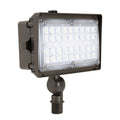
6 Products
Outdoor area lights (often called “shoebox” lights) are pole-mounted luminaires that deliver wide, uniform illumination across parking lots, campuses, plazas, and roadways.
Type II/III for edge-of-lot and roadway lanes, Type IV for forward throw along perimeters/buildings, and Type V for symmetric coverage on centrally placed poles or islands.
Common heights are 15–30 ft for lots/campuses. Taller poles can increase spacing and reduce fixture count, but they need higher output and careful attention to glare control and wind loading.
Match optics to your grid, avoid upward tilt, use full-cutoff distributions, and consider house-side shields near property lines. A photometric layout is the best way to validate uniformity.
Area lights are optimized for uniform, wide coverage from poles; flood lights are more directional for aiming façades, signs, or specific targets. Use each where it excels.
3000–4000 K is comfortable for pedestrians and mixed-use areas; 5000 K emphasizes contrast for security or vehicular environments. Follow local guidelines for light pollution.
Yes—pair photocells for dusk-to-dawn with smart nodes/sensors via NEMA 3/5/7-pin receptacles for scheduling, dimming, and motion response. Controls can materially cut energy and extend life.
Most quality models are IP65+ with sealed optics, corrosion-resistant finishes, and 10–20 kV surge protection. Consider marine-grade options in coastal sites.
Confirm EPA and wind ratings for the entire assembly (fixture + arm + pole). Use properly engineered poles and bases; specify 3G vibration where roadway conditions apply.
Many DLC/DLC Premium area lights qualify for utility incentives. Check your utility’s catalog for specific models and tiers.
Yes—select models include UL 924 battery backup. Alternatively, connect to life-safety circuits/generators to maintain the required 90 minutes of egress illumination (confirm with your local fire marshal or building inspector).
Use 347–480 V drivers on large campuses or industrial feeders. Most commercial sites run 120–277 V universal drivers.